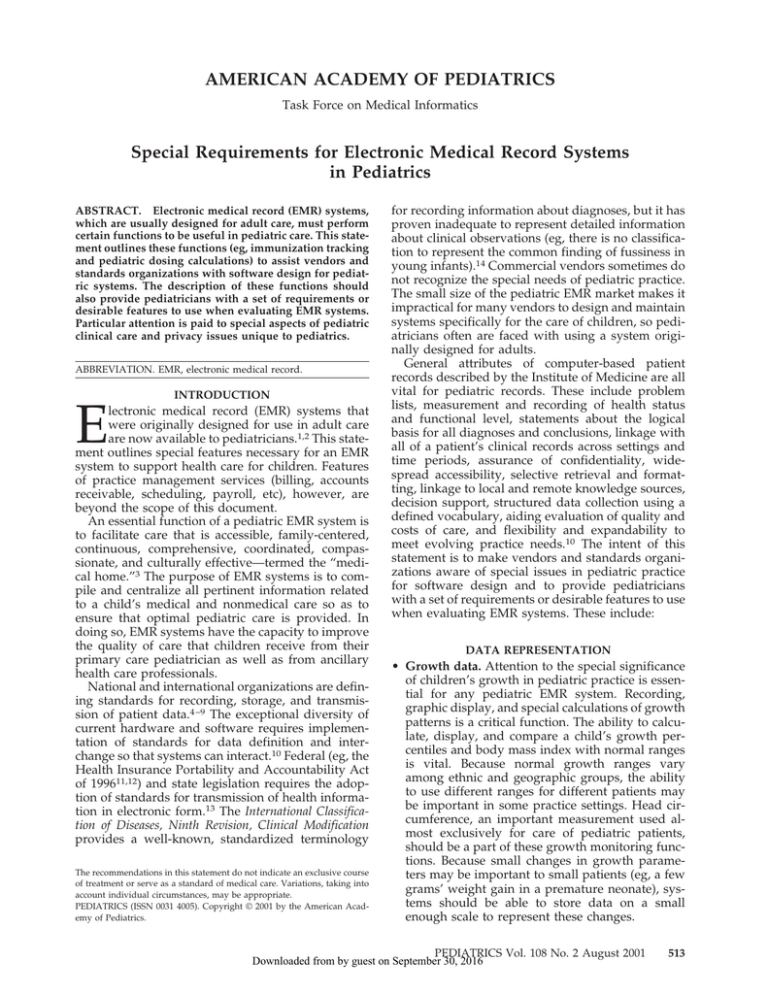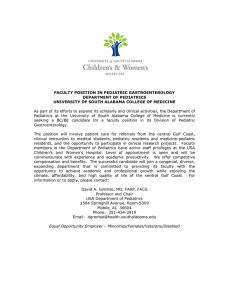
AMERICAN ACADEMY OF PEDIATRICS
Task Force on Medical Informatics
Special Requirements for Electronic Medical Record Systems
in Pediatrics
ABSTRACT. Electronic medical record (EMR) systems,
which are usually designed for adult care, must perform
certain functions to be useful in pediatric care. This statement outlines these functions (eg, immunization tracking
and pediatric dosing calculations) to assist vendors and
standards organizations with software design for pediatric systems. The description of these functions should
also provide pediatricians with a set of requirements or
desirable features to use when evaluating EMR systems.
Particular attention is paid to special aspects of pediatric
clinical care and privacy issues unique to pediatrics.
ABBREVIATION. EMR, electronic medical record.
INTRODUCTION
E
lectronic medical record (EMR) systems that
were originally designed for use in adult care
are now available to pediatricians.1,2 This statement outlines special features necessary for an EMR
system to support health care for children. Features
of practice management services (billing, accounts
receivable, scheduling, payroll, etc), however, are
beyond the scope of this document.
An essential function of a pediatric EMR system is
to facilitate care that is accessible, family-centered,
continuous, comprehensive, coordinated, compassionate, and culturally effective—termed the “medical home.”3 The purpose of EMR systems is to compile and centralize all pertinent information related
to a child’s medical and nonmedical care so as to
ensure that optimal pediatric care is provided. In
doing so, EMR systems have the capacity to improve
the quality of care that children receive from their
primary care pediatrician as well as from ancillary
health care professionals.
National and international organizations are defining standards for recording, storage, and transmission of patient data.4 –9 The exceptional diversity of
current hardware and software requires implementation of standards for data definition and interchange so that systems can interact.10 Federal (eg, the
Health Insurance Portability and Accountability Act
of 199611,12) and state legislation requires the adoption of standards for transmission of health information in electronic form.13 The International Classification of Diseases, Ninth Revision, Clinical Modification
provides a well-known, standardized terminology
The recommendations in this statement do not indicate an exclusive course
of treatment or serve as a standard of medical care. Variations, taking into
account individual circumstances, may be appropriate.
PEDIATRICS (ISSN 0031 4005). Copyright © 2001 by the American Academy of Pediatrics.
for recording information about diagnoses, but it has
proven inadequate to represent detailed information
about clinical observations (eg, there is no classification to represent the common finding of fussiness in
young infants).14 Commercial vendors sometimes do
not recognize the special needs of pediatric practice.
The small size of the pediatric EMR market makes it
impractical for many vendors to design and maintain
systems specifically for the care of children, so pediatricians often are faced with using a system originally designed for adults.
General attributes of computer-based patient
records described by the Institute of Medicine are all
vital for pediatric records. These include problem
lists, measurement and recording of health status
and functional level, statements about the logical
basis for all diagnoses and conclusions, linkage with
all of a patient’s clinical records across settings and
time periods, assurance of confidentiality, widespread accessibility, selective retrieval and formatting, linkage to local and remote knowledge sources,
decision support, structured data collection using a
defined vocabulary, aiding evaluation of quality and
costs of care, and flexibility and expandability to
meet evolving practice needs.10 The intent of this
statement is to make vendors and standards organizations aware of special issues in pediatric practice
for software design and to provide pediatricians
with a set of requirements or desirable features to use
when evaluating EMR systems. These include:
DATA REPRESENTATION
• Growth data. Attention to the special significance
of children’s growth in pediatric practice is essential for any pediatric EMR system. Recording,
graphic display, and special calculations of growth
patterns is a critical function. The ability to calculate, display, and compare a child’s growth percentiles and body mass index with normal ranges
is vital. Because normal growth ranges vary
among ethnic and geographic groups, the ability
to use different ranges for different patients may
be important in some practice settings. Head circumference, an important measurement used almost exclusively for care of pediatric patients,
should be a part of these growth monitoring functions. Because small changes in growth parameters may be important to small patients (eg, a few
grams’ weight gain in a premature neonate), systems should be able to store data on a small
enough scale to represent these changes.
PEDIATRICS Vol. 108 No. 2 August 2001
Downloaded from by guest on September 30, 2016
513
• Patient identifier. A universal patient identifier is
a desirable but as yet unachieved goal. Any system that is ultimately implemented to assign such
identifiers will need to provide for assignment
immediately at the time of birth (or even before
birth for prenatal procedures performed on the
fetus). EMR systems may need to accommodate
temporary (ie, changing) data in this key field,
including certain identifying data associated with
a patient change in the perinatal period. For example, infants are often named with their mother’s
surname or full name (eg, “Infant Boy Smith” or
“Boy June Jones”) at the time of birth, and this is
changed in the first few days of life. Flexibility of
search criteria to allow for changing identification
data are desirable in pediatric systems. Systems
should be able to maintain a record of multiple
names used by a patient.
• Special terminology and information. Special terminology is used in pediatric care. EMR systems
need to include common pediatric terms (a pediatric lexicon) used to describe pediatric preventive
health care (eg, developmental milestones, educational progress, and anticipatory guidance) and
physical findings (eg, weak cry, bulging anterior
fontanelle, and umbilical granuloma). Currently,
standard lexicons are incomplete with respect to
pediatric care; system designers will need to provide supplementary nomenclature or allow users
to augment supplied lexicons in ways that preserve the value of standard vocabularies and adequately represent pediatric concepts.
• Age-based normal ranges. Normal ranges for vital signs and other physiologic parameters change
with a child’s age. Pediatric EMR systems should
allow the user to easily compare a patient’s vital
signs with age-based normal ranges. The same is
true for laboratory values, but normal ranges are
usually supplied by the reference laboratory and
not the EMR; the EMR should be able to accept
normative values provided by the reference laboratory. Systems that allow users to alter normal
ranges to represent specific ethnic or geographic
populations are desirable.
• Time of birth. The time of a child’s birth is important in calculating exact age in the first days of life
and should not be omitted from EMR systems.
DATA PROCESSING
• Prescribing of medications. Prescribing of medications for pediatric patients is based on the age
and weight or body surface area of the child. Prescription tools that supply standard recommended
adult doses and do not include pediatric dose
calculation functions are unlikely to be useful to
pediatricians and may be misleading or potentially dangerous in the pediatric context. Functions
that facilitate calculation of drug doses based on
available data are essential for pediatric care. Decision support tools supplied to assist in selecting
medications and preventing errors should include
pediatric-specific data.
• Immunizations. Efficient recording (data input)
and effective display of immunization data are
514
essential. Mechanisms for immunization decision
support (eg, deficiency alerts) that include easy
updating as recommendations change should be
included.15 For effective interaction with immunization registries, the ability to flexibly format immunization data and support electronic data interchange with registries is vital. Because physicians
who treat infants and children are asked to provide data about immunization completeness in
multiple formats, flexibility in a system’s ability to
provide immunization reports is highly desirable.
Features that support reminder systems to prevent
missed immunizations would be desirable; these
reminder systems can take the form of messages
sent to parents, flags for providers during acute
care, or other forms.
• Parents’ special documentation requirements.
Parents may ask to review or append chart information. Federal regulations (ie, Health Insurance
Portability and Accountability Act privacy regulations12) dictate procedures and limitations of parental appendices to a child’s chart. Systems
should also support the generation and maintenance of summary reports for parents and other
health providers regarding children with special
health care needs.
• Reporting. The ability to easily customize reports
to match mandated formats (eg, school or camp
physicals or reports to school nurses) would be
particularly valuable to pediatric practitioners.
SYSTEM DESIGN
• Special privacy issues.
* Adolescent privacy: Privacy laws regarding adolescents’ medical information (especially sexual
and mental health and behavior issues) vary
from state to state, and policies addressing the
protection of adolescents’ health information
vary from practice to practice. EMR systems
must be able to respond to these privacy needs
by allowing restriction of access to this information according to these laws and policies.12
* Genetic information: EMR systems must provide
protection of information on a patient’s genetic
information, including newborn metabolic
screening results. This protection must extend to
those who are genetically unrelated to their parents (eg, those born after donor embryo procedures).
* Guardianship data: A child’s guardian may be
different from his or her biological parents, and
EMR systems should be able to reflect this.
* Adoption issues: EMR systems must be able to
represent relationships in families involving
adopted children.
* Foster care: Physicians are often asked to evaluate children in foster care. Systems should support reporting requirements of social service
agencies in these cases and protect the privacy of
these patients after changes in a child’s fostercare status.
* Abuse and neglect: State laws vary regarding the
use of data in cases of abuse and neglect. Sys-
ELECTRONIC MEDICAL RECORD SYSTEMS IN PEDIATRICS
Downloaded from by guest on September 30, 2016
•
•
•
•
tems need to be able to protect data in ways
consistent with these laws.
* Financial responsibility data: Sometimes, a parent
or guardian is not the financially responsible
person. Systems should allow enough flexibility
in a patient’s chart to allow identification of this
distinct role.
Pediatric work settings. Data entry (documentation) tools must work in busy pediatric settings.
For example, speech interfaces may be impractical
in noisy environments. Computers in examination
rooms with curious children may also present special challenges for system design.
Family member links. EMR systems should be
able to maintain links to records of other family
members (who may have different surnames) in
the EMR system. Because an interaction with one
family member often triggers an encounter with
another family member (typically a sibling), EMR
systems should support easy movement between
records of children within in the same family.
Registry linkages. EMR systems should promote
linkage to newborn screening systems at the hospital, state, and/or national level so as to ensure
optimal communication including timely notification and follow-up.16
Consideration of national policy statements. The
American Academy of Pediatrics has published
policy statements that may affect the design and
use of EMR systems.3,13,17–28 These policies should
be considered in the design of software systems
for use in pediatric health care.
Task Force on Medical Informatics, 2000 –2001
James Lustig, MD, Chairperson
Edward M. Gotlieb, MD, Vice Chairperson
Larry Deutsch, MD
Robert Gerstle, MD
Allan Lieberthal, MD
Richard Shiffman, MD
S. Andrew Spooner, MD
Melvin Stern, MD
Staff
Rebecca Levin-Goodman
REFERENCES
1. Shiffman R. Informatics and computers in pediatrics. In: Green M,
Haggerty RJ, Weitzman M, eds. Ambulatory Pediatrics. 5th ed. Philadelphia, PA: WB Saunders Co; 1999:62– 67
2. Dickens M, Lighter DE, Lustig JV, Zurhellen W, Zimmerman E, eds.
Computers in the Primary Care Office. 3rd ed. Elk Grove Village, IL:
American Academy of Pediatrics; 1995
3. American Academy of Pediatrics, Ad Hoc Task Force on Definition of
the Medical Home. The medical home. Pediatrics. 1992;90:774
4. Taragin MI, Lauer M, Savir M, Sivan E, Siesel D. HCFA documentation
guidelines and the need for discrete data: a golden opportunity for
applied health informatics. Proc AMIA Annu Fall Symp. 1998;653– 657
5. Coffey RM, Ball JK, Johantgen M, Elixhauser A, Purcell P, Andrews R.
The case for national health data standards. Health Aff (Millwood). 1997;
16:58 –72
6. Health Level Seven Web site. Available at: http://www.hl7.org. Accessed April 20, 2000
7. American Society for Testing and Materials. Committee E31 on Healthcare Informatics. Available at: http://www.astm.org/cgi-bin/
SoftCart.exe/COMMIT/COMMITTEE/E31.htm?L⫹mystore⫹
ocow3633⫹952979939. Accessed April 20, 2000
8. SNOMED International Web site. Available at: http://
www.snomed.org. Accessed April 20, 2000
9. International Organization for Standardization Web site. Available at:
http://www.iso.ch. Accessed April 20, 2000
10. Institute of Medicine. The Computer-Based Patient Record: An Essential
Technology for Health Care. Dick RS, Steen EB, Detmer DE, eds. Washington, DC: National Academy Press; 1997
11. Fitzmaurice JM. A new twist in US health care data standards
development: adoption of electronic health care transactions standards
for administrative simplification. Int J Med Inf. 1998;48:19 –28
12. Health Insurance Portability and Accountability Act, 42 USC §201
(1996)
13. American Academy of Pediatrics, Pediatric Practice Action Group, Task
Force on Medical Informatics. Privacy protection of health information:
patient rights and pediatrician responsibilities. Pediatrics. 1999;104:
973–977
14. McDonald CJ. Quality measures and electronic medical systems. JAMA.
1999;282:1181–1182
15. Miller PL, Frawley SJ, Brandt C, Sayward FG. A prototype Web site for
immunization knowledge maintenance. Proc AMIA Annu Fall Symp.
1997;293–297
16. Health Resources and Services Administration, American Academy of
Pediatrics, Newborn Screening Task Force. Serving the family from
birth to the medical home. Pediatrics. 2000;106(suppl):383– 427
17. American Academy of Pediatrics. Confidentiality in adolescent health
care. AAP News. April 1989;5:9
18. American Academy of Pediatrics, Committee on Pediatric Emergency
Medicine. Consent for medical services for children and adolescents.
Pediatrics. 1993;92:290 –291
19. American Academy of Pediatrics, Task Force on Medical Informatics,
Section on Computers and Other Technologies, Committee on Practice
and Ambulatory Medicine. Safeguards needed in the transfer of patient
data. Pediatrics. 1996;98:984 –986
20. American Academy of Pediatrics, Committee on Injury and Poison
Prevention. The hospital record of the injured child and the need for
external cause-of-injury codes. Pediatrics. 1999;103:524 –526
21. American Academy of Pediatrics, Committee on Early Childhood,
Adoption, and Dependent Care. Initial medical evaluation of an
adopted child. Pediatrics. 1991;88:642– 644
22. American Academy of Pediatrics, Committee on Genetics. Prenatal
genetic diagnosis for pediatricians. Pediatrics. 1994;93:1010 –1015
23. American Academy of Pediatrics, Committee on Child Abuse and
Neglect. Public disclosure of private information about victims of abuse.
Pediatrics. 1991;87:261
24. American Academy of Pediatrics, Task Force on Pediatric AIDS. Adolescents and human immunodeficiency virus infection: the role of the
pediatrician in prevention and intervention. Pediatrics. 1993;92:626 – 630
25. American Academy of Pediatrics, Committee on Adolescence. Contraception and adolescents. Pediatrics. 1999;104:1161–1166
26. American Academy of Pediatrics, Committee on Substance Abuse. Testing for drugs of abuse in children and adolescents. Pediatrics. 1996;98:
305–307
27. American Academy of Pediatrics, Committee on Adolescence. The adolescent’s right to confidential care when considering an abortion. Pediatrics. 1996;97:746 –751
28. American Academy of Pediatrics, Committee on Early Childhood,
Adoption, and Dependent Care. Issues of confidentiality in adoption:
the role of the pediatrician. Pediatrics. 1994;93:339 –341
AMERICAN ACADEMY OF PEDIATRICS
Downloaded from by guest on September 30, 2016
515
Special Requirements for Electronic Medical Record Systems in Pediatrics
Task Force on Medical Informatics
Pediatrics 2001;108;513
DOI: 10.1542/peds.108.2.513
Updated Information &
Services
including high resolution figures, can be found at:
/content/108/2/513.full.html
References
This article cites 17 articles, 14 of which can be accessed free
at:
/content/108/2/513.full.html#ref-list-1
Citations
This article has been cited by 18 HighWire-hosted articles:
/content/108/2/513.full.html#related-urls
Subspecialty Collections
This article, along with others on similar topics, appears in the
following collection(s):
Administration/Practice Management
/cgi/collection/administration:practice_management_sub
Permissions & Licensing
Information about reproducing this article in parts (figures,
tables) or in its entirety can be found online at:
/site/misc/Permissions.xhtml
Reprints
Information about ordering reprints can be found online:
/site/misc/reprints.xhtml
PEDIATRICS is the official journal of the American Academy of Pediatrics. A monthly
publication, it has been published continuously since 1948. PEDIATRICS is owned, published,
and trademarked by the American Academy of Pediatrics, 141 Northwest Point Boulevard, Elk
Grove Village, Illinois, 60007. Copyright © 2001 by the American Academy of Pediatrics. All
rights reserved. Print ISSN: 0031-4005. Online ISSN: 1098-4275.
Downloaded from by guest on September 30, 2016
Special Requirements for Electronic Medical Record Systems in Pediatrics
Task Force on Medical Informatics
Pediatrics 2001;108;513
DOI: 10.1542/peds.108.2.513
The online version of this article, along with updated information and services, is
located on the World Wide Web at:
/content/108/2/513.full.html
PEDIATRICS is the official journal of the American Academy of Pediatrics. A monthly
publication, it has been published continuously since 1948. PEDIATRICS is owned,
published, and trademarked by the American Academy of Pediatrics, 141 Northwest Point
Boulevard, Elk Grove Village, Illinois, 60007. Copyright © 2001 by the American Academy
of Pediatrics. All rights reserved. Print ISSN: 0031-4005. Online ISSN: 1098-4275.
Downloaded from by guest on September 30, 2016




